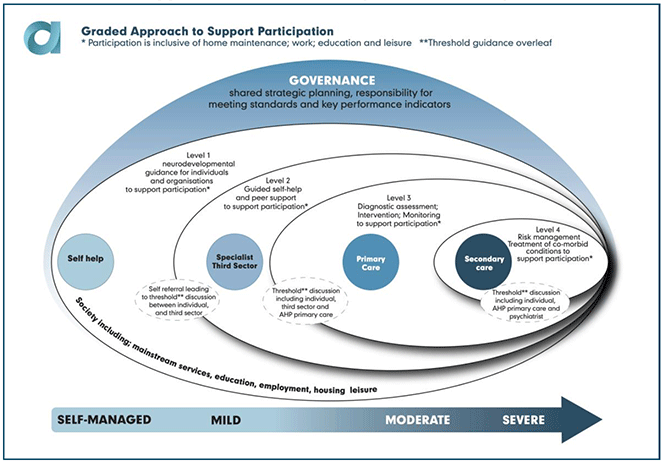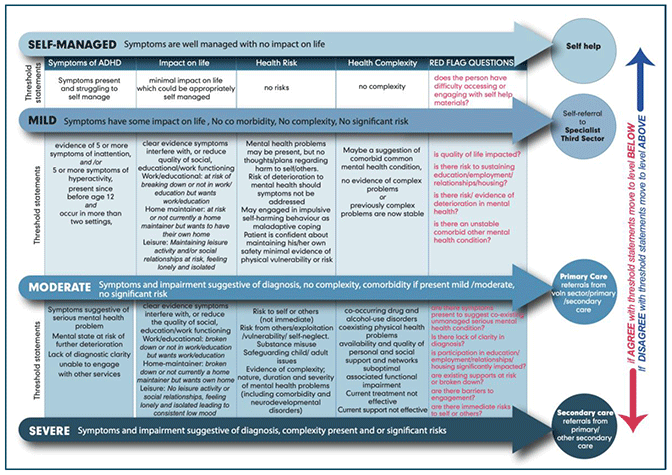NAIT Adult Neurodevelopmental Pathways report
In 2021, there was a recognised need to improve experiences and outcomes for autistic adults, adults with ADHD and those with co-occurring neurodevelopmental conditions in Scotland. This report details innovative and new ways of working towards these goals, including future recommendations.
Appendix 1: NAIT Stepped Care Neurodevelopmental Pathway

Self-managed: symptoms are well managed with no impact on life
Outcome: self help
Threshold statements
Symptoms of ADHD: symptoms present and struggling to self-manage.
Impact on life: minimal impact on life which could be appropriately self-managed.
Health risk: no risks.
Health complexity: no complexity.
Red flag questions: does the person have difficulty accessing or engagement with self-help materials?
Mild: symptoms have some impact on life, no co-morbidity, no complexity, no significant risk.
Outcome: self-referral to specialist third sector.
Threshold statements
Symptoms of ADHD: evidence of 5 or more symptoms of inattention, and/or 5 or more symptoms of hyperactivity, present since before age 12 and occur in more than two settings.
Impact on life: clear evidence symptoms interfere with, or reduce quality of social, educational/work functioning. Work/educational: at risk of breaking down or not in work/education but wants work/education. Home maintainer: at risk or not currently a home maintainer but wants to have their own home. Leisure: maintaining leisure activity and/or social relationships at risk, feeling lonely and isolated.
Health risk: Mental health problems may be present, but no thoughts/plans regarding harm to self/others. Risk of deterioration to mental health should symptoms not be addressed. May engage in impulsive self-harm behaviour as maladaptive coping. Patient is confident about maintaining his/her own safety, minimal evidence of physical vulnerability or risk.
Health complexity: Maybe a suggestion of comorbid common mental health condition, no evidence of complex problems or previously complex problems are now stable.
Red flag questions: Is quality of life impacted? Is there a risk to sustaining educational/employment/relationships/housing? Is there risk/evidence of deterioration in mental health? Is there an unstable comorbid other mental health condition?
Moderate: symptoms and impairment suggestive of diagnosis, no complexity, comorbidity if present mild/moderate.
Outcome: Primary care referrals from voluntary sector/primary/secondar care.
Threshold statements
Symptoms of ADHD: Symptoms suggestive of serious mental health problem, Mental state at risk of further deterioration, lack of diagnostic clarity unable to engage with other services.
Impact on life: Clear evidence symptoms interfere with, or reduce the quality of social, education/work functioning, Work/educational: broken down or not in work/education. Home maintainer: broken down or not currently a home maintainer but wants own home, Leisure: No leisure activity or social relationships, feeling lonely and isolated leading to consistent low mood.
Health risk: Risk to self or others (not immediate), Risk from others/exploitation/vulnerability/ self-neglect. Substance misuse, Safeguarding child/adult issues, Evidence of complexity; nature, duration and severity of mental health problems (including comorbidity and neurodevelopmental disorders)
Health complexity: Co-occurring drug and alcohol-use disorders, coexisting physical health problems, availability and quality of personal and social support networks, suboptimal associated functional impairment, current treatment not effective, current support not effective.
Red flag questions: Are there symptoms present to suggest co-existing unmanaged serious health condition? Is there lack of clarity in diagnosis? Is participation in education/employment/relationships/housing significantly impacted? Are existing supports at risk or broken down? Are there barriers to engagement? Are there immediate risks to self or others?
Severe: symptoms and impairment suggestive of diagnosis, complexity present and or significant risks.
Outcome: secondary care referrals from primary/other secondary care.
Below table is a visual representation of the above:

Contact
There is a problem
Thanks for your feedback